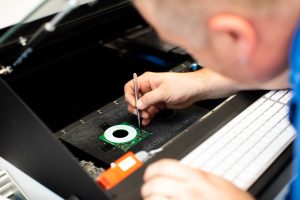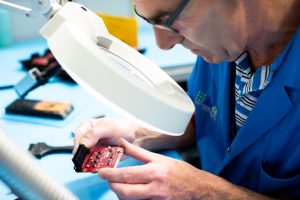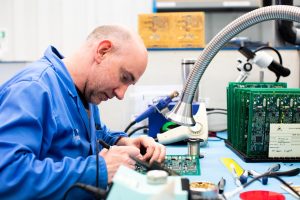In a world reliant on electronic devices, the quality and reliability of Printed Circuit Board assemblies (PCBAs) have never been more crucial. Particularly in industries where products are life-critical, the emphasis on defect-free PCBAs is paramount. Although no manufacturing process can be 100% flawless, the key is to understand potential defects, why they occur, and how to mitigate them effectively. With MPE Electronics’ commitment to excellence, here’s your guide to common defects in PCB assembly and the measures to prevent them.
The Prevalence of PCB Assembly Defects
Defective PCB assemblies are more than just a minor inconvenience. They can translate into increased costs, delays and a dent in your reputation. While some may argue that defects are part of any manufacturing process, leading manufacturers, such as MPE Electronics, aim to reduce these occurrences to an absolute minimum.

Common Defects in PCB Manufacturing and How to Prevent Them
- Solder Bridging: Occurs when solder connects two or more adjacent pads, causing a short circuit.
Mitigation: Accurate stencil printing and proper reflow profiles. - Lifting Pads: Caused by excessive heat or mechanical stress during soldering.
Mitigation: Use of lower melting point solders and careful handling during assembly. - Tombstoning: A component lifts from the board during soldering, resembling a tombstone.
Mitigation: Accurate placement and careful review of reflow profiles. - Insufficient Solder: Leads to poor joint integrity.
Mitigation: Proper stencil design and adequate solder paste application. - Open Joints: Occur when solder doesn’t wet the surface adequately.
Mitigation: Ensuring clean surfaces and proper flux application.
What causes a PCB Assembly to fail?
When discussing the failure of PCB assemblies, it’s essential to explore the various factors that can lead to such outcomes. Since MPE Electronics specialises in assembling components onto Printed Circuit Boards, we should focus on the issues that are directly related to this process. The failure of a PCB assembly can usually be attributed to one or more of the following factors:
- Component Placement: Inaccurate or imprecise placement of components on a Printed Circuit Board can disrupt its intended functionality. This could manifest as poor electrical connections or even short circuits, leading to failure.
- Soldering Issues: Substandard soldering techniques can result in a variety of problems, such as cold joints, voids, or solder bridges. These issues can compromise the electrical integrity of the assembly, causing individual components to fail or even damage to the assembly itself.
- Human Error: Even with state-of-the-art technology, human intervention can introduce errors that make an assembly prone to failure. Errors such as incorrect component placement or poor soldering can arise, often leading to issues that are challenging to correct once the assembly has been produced.
- Environmental Stress: Factors like temperature fluctuations, moisture, and corrosive elements can have a detrimental impact on the components and solder joints of a PCB assembly. Over time, these environmental stresses can weaken the assembly’s structural integrity.
- Electrical Overstress: Exposing the PCB assembly to voltage or currents beyond its designed specifications can lead to immediate or gradual failure, affecting either individual components or the entire assembly.
- Assembly Process: Inconsistencies in the component assembly process, such as variations in solder paste application or temperature profiles during reflow soldering, can introduce defects that compromise the assembly’s reliability.
By scrupulously addressing these areas through our quality assurance protocols and precise assembly procedures, MPE Electronics aims to minimise these risks. This underlines our steadfast commitment to delivering PCB assemblies of the highest quality and reliability.

How do you identify a defect in a PCB?
Identifying defects in a PCB assembly is a multifaceted process that utilises various methods to ensure optimal performance and reliability. Here’s an expanded look at common techniques for defect identification:
- Visual Inspection: This is the most straightforward method and often the first line of defence against defects. Trained personnel closely scrutinise the PCB assembly to spot any glaring issues, such as misplaced components, solder splashes or misaligned traces. However, this method may not catch more subtle or internal defects.
- X-ray Analysis: For more complex assemblies where components are densely packed or even hidden from view, X-ray analysis is a more appropriate tool. This technology allows inspectors to see through the board and components to identify problems such as solder voids, internal trace defects or misaligned, buried components.
- Electrical Testing: This encompasses a range of procedures, including in-circuit tests and functional tests, which can identify issues with electrical connections, the functionality of the assembly or the behaviour of the assembly under operating conditions. These tests can catch defects that visual and X-ray methods might miss, including poor electrical connections and malfunctioning components.
- Automated Optical Inspection (AOI): This involves scanning the PCB with a camera to compare it against a digital model. The system automatically identifies deviations from the model, which could be indicative of potential defects.
- Thermal Imaging: Some defects manifest themselves through irregular heat distribution when the PCB assembly is in operation. Thermal cameras can capture these anomalies, indicating potential issues, such as a short circuit or a malfunctioning component.
- Acoustic Imaging: This is a less common but useful technique for identifying defects, such as delamination, cracks or voids within the layers of the PCB assembly, by using sound waves to create a visual representation of the assembly’s internal structure.
By leveraging these methods in a comprehensive testing strategy, MPE Electronics ensures that any defects are promptly identified and addressed. Such meticulous attention to detail is central to MPE’s commitment to delivering high-quality, reliable PCB assemblies.
Surface Mount Technology (SMT) PCB Assembly Defects: A Special Consideration
In the broader scope of PCB assembly defects, issues specific to Surface Mount Technology (SMT) require a separate mention. SMT is a method where components are mounted directly on to the surface of a PCB. This approach has several benefits, such as reduced board size and enhanced performance. However, it’s not without its unique set of challenges.
Common SMT defects include skewing, where components shift from their original position, and tombstoning, where components lift off the board during reflow and resemble a tombstone. Additionally, solder wicking can occur, where solder flows away from the joint, causing weak bonds or even disconnection.
Mitigating SMT-specific defects often involves careful attention to the solder paste application process and precise temperature control during reflow soldering. The use of Automated Optical Inspection (AOI) systems and X-ray inspection techniques is particularly beneficial in detecting these SMT-specific defects.
By being vigilant about these unique challenges in SMT PCB assembly, MPE Electronics minimises the likelihood of these defects, contributing to the production of high-quality, reliable PCB assemblies.

IPC Class 3 Workmanship Standards: A Benchmark for Quality
IPC Class 3 Workmanship Standards stand as a rigorous set of guidelines that set the benchmark for quality in electronics manufacturing. These standards are particularly critical for sectors where both reliability and high performance are non-negotiable, such as in aerospace, healthcare technology and military applications. Adherence to IPC Class 3 criteria goes far beyond basic visual and mechanical inspections. It delves into the minutiae of component placement, soldering quality and material specifications, demanding nothing short of excellence in each of these areas.
At MPE Electronics, the commitment to IPC Class 3 Workmanship Standards is unyielding. All production staff undergo detailed training and are certified to this standard. This ensures that every PCB assembly produced meets stringent quality expectations, making MPE Electronics a reliable partner for industries where the margin for error must be virtually non-existent.
Rework and Repair: The MPE Approach
Even with the best preventive measures, defects can occasionally occur. MPE Electronics offers rework and repair services that are swift and seamless. We prioritise immediate action to correct any shortcomings, ensuring minimal disruption to your project timelines.
At MPE Electronics, transparency isn’t just a buzzword; it’s a commitment we take very seriously. Our dedication to excellence extends to offering our clients real-time insights into our performance metrics. For a deeper understanding of our unwavering focus on quality and performance, take a look at our monthly sales volume and quality performance rates for 2022.
FAQs About PCB Assembly Defects
Why am I receiving faulty PCB assemblies from my current supplier?
Lack of adherence to industry standards could be the culprit. Make sure your supplier is IPC Class 3 and ISO 9001:2015 certified, like MPE Electronics.
Is it normal to have defects?
While zero defects are the ideal, a certain level of defects is often considered an industry norm. However, leading manufacturers like MPE aim to minimise these to an absolute rarity.
What can be done about defective PCB assemblies?
Engage a supplier committed to quality and swift action for rework and repairs.
In conclusion
As a client-oriented electronics manufacturer, MPE Electronics is dedicated to ensuring that your PCB assemblies are as close to perfect as possible. Our continuous investment in staff training and the latest technology provides you with the most reliable and highest-quality PCB assemblies. With us as your manufacturing partner, defective PCB assemblies will be the least of your worries.
Ready to make the switch to quality and reliability?
Explore MPE’s services and consider making us your trusted PCB assembly supplier.
MPE Electronics:
MPE Electronics is an established and experienced contract electronics manufacturer specialising in PCB assemblies and full box build assembly for a wide range of commercial and industrial businesses.
To find out how MPE Electronics’ PCB manufacturing and assembly services can benefit your business, contact our expert and friendly team on +44 (0)1825 764822 or enquiries@mpe-electronics.co.uk.

